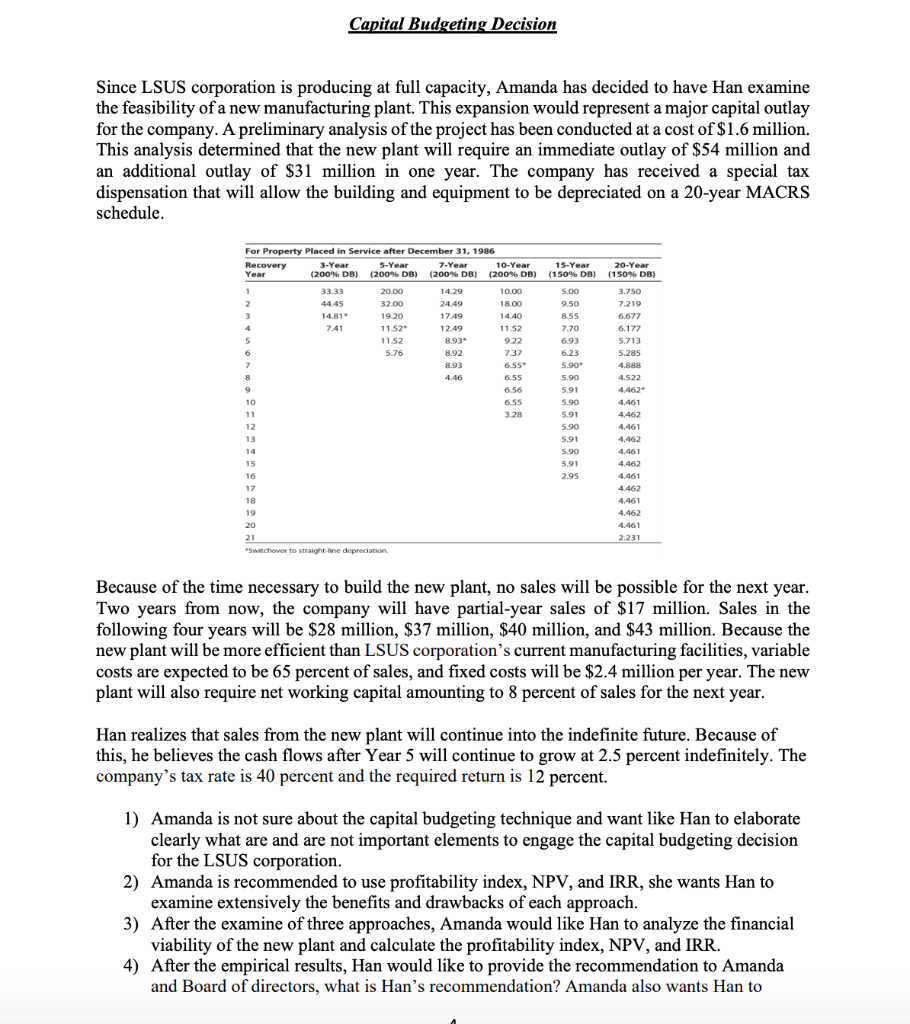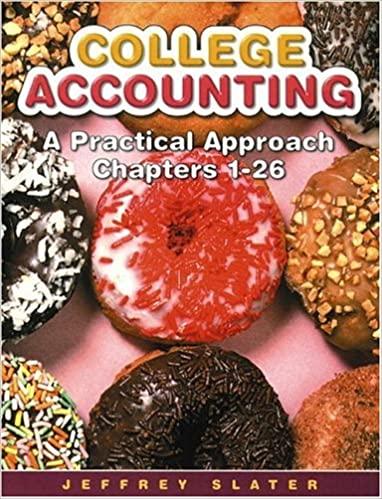 Please answer question #3 with the formulas and how to do it step by step
Please answer question #3 with the formulas and how to do it step by step
Capital Budgeting Decision Since LSUS corporation is producing at full capacity, Amanda has decided to have Han examine the feasibility of a new manufacturing plant. This expansion would represent a major capital outlay for the company. A preliminary analysis of the project has been conducted at a cost of $1.6 million. This analysis determined that the new plant will require an immediate outlay of $54 million and an additional outlay of $31 million in one year. The company has received a special tax dispensation that will allow the building and equipment to be depreciated on a 20-year MACRS schedule. For Property Placed in Service after December 31, 1986 Recovery 3-Year 5-Year 7-Year 10-Year 15-Year 20-Year Year (200% DB) (200% DB) (200% DB) (200% DB) (150% DB) (150% DB) 1 33.33 20.00 14.29 10.00 5.00 3.750 2 44.45 32.00 24.49 18.00 9.50 7.219 3 14.81 19.20 17.49 14.40 8.55 6.677 4 7.41 1152 12.49 11.52 7.70 6.177 5 11.52 8.93 9.22 6.93 5.713 6 5.76 8.92 737 6.23 5.285 7 8.93 6.55* 5.900 4.888 8 4.46 6.55 5.90 4.522 9 6.56 5.91 4.462 10 6.55 5.90 4.461 11 3.28 5.91 4.462 12 5.90 4.461 13 5.91 4.462 14 5.90 4.461 15 5.91 4.462 16 2.95 4.461 17 4.462 18 4.461 19 4.462 20 4.461 21 2.231 Switchover to straight line depreciation Because of the time necessary to build the new plant, no sales will be possible for the next year. Two years from now, the company will have partial-year sales of $17 million. Sales in the following four years will be $28 million, $37 million, $40 million, and $43 million. Because the new plant will be more efficient than LSUS corporation's current manufacturing facilities, variable costs are expected to be 65 percent of sales, and fixed costs will be $2.4 million per year. The new plant will also require net working capital amounting to 8 percent of sales for the next year. Han realizes that sales from the new plant will continue into the indefinite future. Because of this, he believes the cash flows after Year 5 will continue to grow at 2.5 percent indefinitely. The company's tax rate is 40 percent and the required return is 12 percent. 1) Amanda is not sure about the capital budgeting technique and want like Han to elaborate clearly what are and are not important elements to engage the capital budgeting decision for the LSUS corporation. 2) Amanda is recommended to use profitability index, NPV, and IRR, she wants Han to examine extensively the benefits and drawbacks of each approach. 3) After the examine of three approaches, Amanda would like Han to analyze the financial viability of the new plant and calculate the profitability index, NPV, and IRR. 4) After the empirical results, Han would like to provide the recommendation to Amanda and Board of directors, what is Han's recommendation? Amanda also wants Han to Capital Budgeting Decision Since LSUS corporation is producing at full capacity, Amanda has decided to have Han examine the feasibility of a new manufacturing plant. This expansion would represent a major capital outlay for the company. A preliminary analysis of the project has been conducted at a cost of $1.6 million. This analysis determined that the new plant will require an immediate outlay of $54 million and an additional outlay of $31 million in one year. The company has received a special tax dispensation that will allow the building and equipment to be depreciated on a 20-year MACRS schedule. For Property Placed in Service after December 31, 1986 Recovery 3-Year 5-Year 7-Year 10-Year 15-Year 20-Year Year (200% DB) (200% DB) (200% DB) (200% DB) (150% DB) (150% DB) 1 33.33 20.00 14.29 10.00 5.00 3.750 2 44.45 32.00 24.49 18.00 9.50 7.219 3 14.81 19.20 17.49 14.40 8.55 6.677 4 7.41 1152 12.49 11.52 7.70 6.177 5 11.52 8.93 9.22 6.93 5.713 6 5.76 8.92 737 6.23 5.285 7 8.93 6.55* 5.900 4.888 8 4.46 6.55 5.90 4.522 9 6.56 5.91 4.462 10 6.55 5.90 4.461 11 3.28 5.91 4.462 12 5.90 4.461 13 5.91 4.462 14 5.90 4.461 15 5.91 4.462 16 2.95 4.461 17 4.462 18 4.461 19 4.462 20 4.461 21 2.231 Switchover to straight line depreciation Because of the time necessary to build the new plant, no sales will be possible for the next year. Two years from now, the company will have partial-year sales of $17 million. Sales in the following four years will be $28 million, $37 million, $40 million, and $43 million. Because the new plant will be more efficient than LSUS corporation's current manufacturing facilities, variable costs are expected to be 65 percent of sales, and fixed costs will be $2.4 million per year. The new plant will also require net working capital amounting to 8 percent of sales for the next year. Han realizes that sales from the new plant will continue into the indefinite future. Because of this, he believes the cash flows after Year 5 will continue to grow at 2.5 percent indefinitely. The company's tax rate is 40 percent and the required return is 12 percent. 1) Amanda is not sure about the capital budgeting technique and want like Han to elaborate clearly what are and are not important elements to engage the capital budgeting decision for the LSUS corporation. 2) Amanda is recommended to use profitability index, NPV, and IRR, she wants Han to examine extensively the benefits and drawbacks of each approach. 3) After the examine of three approaches, Amanda would like Han to analyze the financial viability of the new plant and calculate the profitability index, NPV, and IRR. 4) After the empirical results, Han would like to provide the recommendation to Amanda and Board of directors, what is Han's recommendation? Amanda also wants Han to
 Please answer question #3 with the formulas and how to do it step by step
Please answer question #3 with the formulas and how to do it step by step





